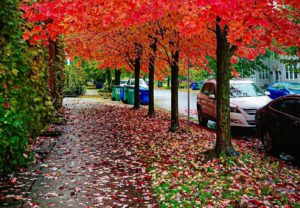Author: Lauren Wesp
As Autumn arrives, Buffalo is slowly beginning the process of morphing into a landscape of warm hues. The intensely vivid colors of fall add even more beauty to an already scenic backdrop, from downtown skyscrapers, to historic grain mills, to houses/mansions from the early 20th Century, to a vibrant waterfront, and Olmsted Parks.
Though, as the array of red, yellow, and orange leaves commence their annual fall and will soon begin piling up, I trust that many Buffalonians are already dreading the backbreaking labor of attempting to eliminate each and every leaf that dares to hit the ground. But maybe we should just leave the leaves on our lawns?
Buffalo is known as the “City of Good Neighbors,” so of course, we want to be responsible members of our community. As good neighbors, we probably feel a duty towards the upkeep of the outdoor spaces of the buildings we inhabit. And raking up leaves, gathering them into bags, and tossing them into trash bins just seems like part of the whole deal. So I completely understand if you are feeling somewhat skeptical of my proposal and fully acknowledge that it could sound kind of crazy.
It might surprise you, though, to find out that raking leaves is actually a bit of a modern fad. It wasn’t until the 1930s that most people began using rakes to scour the ground, grabbing up leaves.
It’s all part of a more general trend toward overly manicuring our environment (along with practices like creating seas of shortened, dandelion-free grass or neatly sculpted bushes with not a leaf out of place). As a show of wealth and status, upper-class Britons in the 17th Century would demonstrate that they could afford to waste space with their highly tamed, pristine lawns.
In a bid to appear wealthy, the average person began adapting these status symbol lawns, until they eventually became the norm.
In a bid to appear wealthy, the average person began adapting these status symbol lawns, until they eventually became the norm.
Aside from seeming like we are imitating 17th Century British aristocratic aesthetics, though, you might be wondering if there are any other downsides to having leaf-free lawns. Obviously, it takes a good deal of time and energy to rake lawns, which could be a positive or a negative, depending on whether one enjoys raking. From an environmental standpoint, however, the value in raking (or not raking) is more clear-cut.
As mentioned earlier, raked leaves usually get compiled into bags before being tossed away. So there are multiple layers of issues at hand. The first would be the bags. Plastic garbage bags will have the harshest environmental impact, with the plastic taking an immense amount of time to decompose. If you plan to continue raking leaves, repurposing other bags, like perhaps some paper grocery bags you’ve got kicking around, would create a smaller impact. Regardless of the type of bag used, however, when we throw away our piles of leaves, they add weight to the garbage trucks, which burns extra fuel in the transportation process. Ultimately, the leaves make their way to their final destination, taking up space in landfills.
Next, let’s consider the soil and the plants that grow in it. Some people are afraid that a blanket of leaves atop their grass (that aristocracy-style grass) will lead to its demise. But simply breaking up the leaves with something like a lawn mower will create a layer of mulch. This will make it easier for the leaves to break down while allowing the grass to breathe.
Packed with nutrients, the leaves will biodegrade and leave behind healthier soil. And if you really don’t feel comfortable keeping leaves on your lawn, another option would be to rake them up to be placed in a compost bin, thus still creating more nutritious soil. If you don’t own a compost bin, you can sign up for a composting service with organizations like Farmer Pirates.
Finally, we’ll take a look at the impact of raking on wildlife. Thousands of species, from caterpillars, to turtles, to chipmunks make their homes within the fallen leaves. So by disposing of the leaves, we are also throwing away wildlife habitats. When we instead choose to leave our leaves on the ground, we are helping animals to find essential resources that they need to survive. And to truly be a city of good neighbors, we can extend kindness to all of our neighbors, regardless of their species.
How often do we get a chance to do good by doing less?
All that being said, I can see why people might still be apprehensive about leaving the leaves on their lawns. I totally get being worried about your neighbors side-eyeing you for the apparent infraction of not maintaining a spotless lawn. It’s also an opportunity, though, to be a trendsetter while feeling good about doing something to benefit the environment. And how often do we get a chance to do good by doing less? Plus, now that you are informed about the environmental impacts of raking, you are well equipped to spit out knowledge defending your leafy lawn to any neighbor who might make a snippy comment.
On a final note, I absolutely do not discourage anyone from raking their leaves into a condensed area and jumping in said leaf pile before returning the leaves to their lawns. Some traditions should be here to stay!
The post Let’s Leave the Leaves appeared first on Buffalo Rising.

